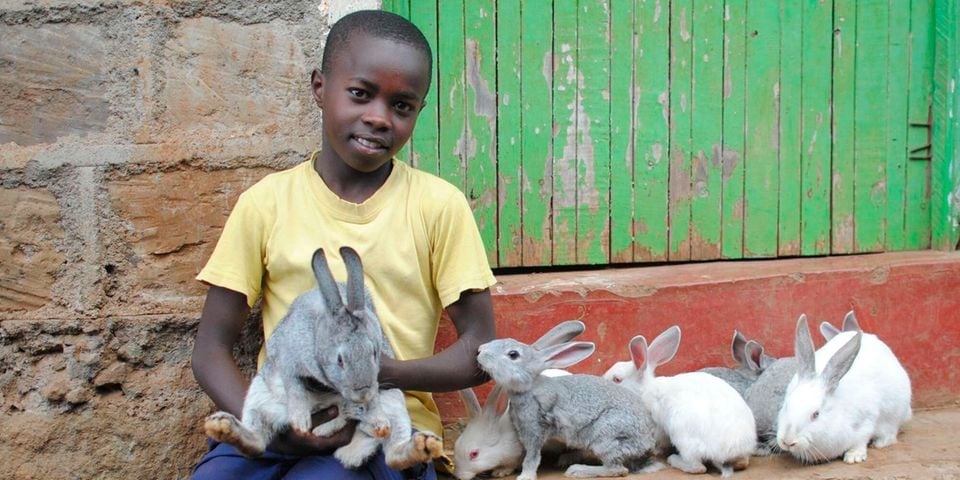Prime
Some important facts on rabbits

Rabbits have mainly been kept as pets in Uganda by boys. Photo | NMG
What you need to know:
- If a rabbit consumes an excess of starchy feed, it should be withdrawn from the feed and put on dry grass hay until the issue is resolved in three to five days.
They are gentle, calm and adorable. However, they can be aggressive and even injure people when in the peak of their reproductive phase.
But that phase is short-lived and mainly happens where there is male-male or female-female competition for mates.
Male and female rabbits spray urine about and become aggressive during the prime of reproduction.
A handler appearing to prevent a rabbit from accessing a mate may get clawed or bitten.
Rearing rabbits as livestock
Though rabbits have mainly been kept as pets by boys, the animals are slowly picking up as livestock for commercial production of food, fur, skin and laboratory research.
Recently, I attended to a farmer who is raising rabbits for the first time and wishes to get some key facts about the animals as the beginning of her journey towards understanding the creatures. After confirming her rabbits were healthy, I gave her a brief overview.
The domestic rabbit is scientifically called Oryctolagus cuniculus. It is a descendant of wild rabbits that inhabit western Europe and north Africa.
In their natural environment, rabbits live in groups and reproduce successfully.
When the British introduced the animals in Australia in the 1800s, they quickly multiplied to be a pest that damaged agricultural produce, pasture and the environment.
Rabbits are herbivorous, meaning they only feed on plants. They prefer to forage in the twilight or night time hours.
Rabbits use their claws to dig and burrow into the ground for shelter and protection. If threatened, they choose to run, manoeuvre and escape harm rather than fight.
Most domesticated rabbits are sheltered to protect them from predators and the weather.
Breeding
Rabbits and horses belong to the same class of herbivores called hind-gut fermenters.
Unlike cattle, sheep and goats, they digest consumed plant material to extract nutrients in the large intestines and the caecum. Akin to cattle, sheep and goats, rabbits do not vomit.
The animals have a lifespan of five to 10 years and rarely attain 15.
Males reach breeding age at six to 10 months and females five to nine. A rabbit’s gestation period is 29 to 35 days. They give birth to four to 10 young called bunnies. Giving birth in rabbits is called kindling. A male breeding rabbit is called a buck and the female a doe.
Feeding rabbits
Females can be bred 21 days from kindling. This explains the very high multiplication rate for the species.
Non-commercial rabbits should be fed grass hay, green leafy vegetables and fruits. They may also be fed green grass.
The animals should be given a combination of three different vegetables daily to provide the required nutrients.
Quality clean water should be provided for the rabbits to drink at will.
Rabbits normally drink little water if they are fed large quantities of fresh vegetables as they will get most of their water requirement from the forage.
Lucern hay may be given to rabbits but in small quantities. Its high protein content tends to disrupt the animal’s digestive system and causes production of loose stool and bacterial infection.
Where sufficient quantities of forage and hay is not available, non-commercial rabbits may be supplemented with commercial pelleted feed.
Commercial rabbits should be given pelleted feed, made from corn, hay, lucern, minerals and vitamins.
This enables rapid growth and weight gain. Some rabbits tend to react to pelleted feed, getting diarrhoea.
Should that happen, the animals need to be put on grass hay and the pellets reintroduced slowly.
Rabbits are the most sensitive of domestic animals to diet change. Even moving a rabbit from a high vegetable diet to a high grass diet can cause death.
Diet changes should be gradual and monitored closely. Dry hay is always good in managing undesirable effects of rapid feed change.
Just like ruminants, rabbits are not able to handle large quantities of high starch diets properly due to abnormal fermentation that produces a lot of acid.
But rabbits really love starchy feeds such as bread, wheat and oat.
If a rabbit consumes an excess of starchy feed, it should be withdrawn from the feed and put on dry grass hay until the issue is resolved in three to five days. Like elephants, rabbits have a peculiar tendency of eating their faeces.
This is the first faeces produced in the morning and is called “night pellets”. It is covered with mucous and has been found to be rich in proteins.
The habit is normal and causes no problem to the rabbits. They pick the pellets as they come out of the anus. Many rabbit owners do not notice that because it happens early in the morning.
One great challenge with rabbits is their adverse reaction to many drugs that are very safe in other animals.
The widely-used penicillin and penicillin related drugs like amoxicillin are very toxic to rabbits when given by mouth, for instance.
Pyrethrum-based drugs used to control external parasites in many animal species are also toxic to rabbits.
I advise farmers and keepers of rabbits to always confirm the use of any drug or chemical in or on rabbits before application to avoid poisoning.
The two most problematic micro-organisms in rabbits are the bacterium Pasteurella multocida and myxomatosis virus.
The bacteria causes fatal eye infections, pneumonia, skin and internal abscesses.
Myxomatosis causes ulcers on the skin and eyes, pneumonia and death. It has no cure but is prevented by vaccination.





